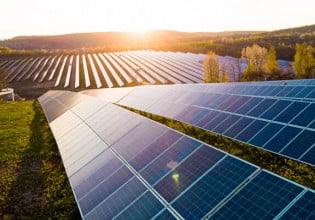Emerson Network Power Identifies Key Applications for 400Vdc Power Technology
Rising energy costs and power demand, combined with mainstream adoption of renewable energy sources, are driving adoption of new power architectures, such as 400V direct current (dc), that enable more efficient networks and businesses. Emerson Network Power has identified and analyzed four applications poised to benefit from the emergence of 400Vdc power distribution technology as a viable alternative to traditional power architectures.
Direct and alternating current (ac) technologies have been evolving since Tesla and Edison competed in the late 1800s to establish a distribution method for the electric grid. At that time, technologies were not available to safely and economically use dc power over long distances and ac power won out on the grid. Today, long-distance dc power use is cost effective, dc-based renewable energy is proliferating, and most technology equipment operates on dc power. The grid still distributes ac power, however, creating growing inefficiencies in our power-hungry, technology-driven world.
"Recent advances in power conversion technologies, combined with rapidly increasing dc-based equipment growth, have created an environment where 400Vdc power distribution should be – and is being – actively considered," said Mark Murrill, director of 400Vdc power initiatives for Emerson Network Power. "Global architecture standards required for widespread implementation of 400Vdc are well under way, as demonstrated with the European Telecommunications Standards Institute (ETSI) EN 300 132-3-1 standard released in February 2012. As more and more vendors support this standard, the adoption of 400Vdc will begin to rapidly increase in various applications and further standards will be clarified and adopted."
Emerson Network Power currently sees four primary applications for 400Vdc technology: telecom central offices, data centers, commercial buildings, and transportation – each with its own drivers for adoption.
Unlike the grid, telecommunications networks have long used dc distribution, largely for its high reliability and good signal quality performance. As telecom equipment has moved to silicon-based dc technology, alignment between existing dc power distribution and dc-driven equipment is already in place, but cost and efficiency gains are still possible. For example, 400Vdc is especially suited for high power delivery over long distances, because it reduces installation and operational costs and improves cable management versus -48Vdc. These benefits are realized due to at least an 80 percent reduction of copper wire used, affecting both the cost of and time needed for installation. In addition, reduced line losses typically will increase end-to-end energy efficiency as well, further reducing operating costs.
The logic behind 400Vdc power in the data center is driven by the need for high availability, high efficiency and lower total costs. Since utility ac power ultimately must be converted to dc power for use by all IT equipment and because stored energy systems (batteries, flywheels, etc.) and renewable sources provide dc power, a typical dc power architecture requires fewer power conversions from grid to chip. Reducing these conversions not only saves energy, but also can increase critical power availability through simplified distribution and reduction of failure points in the power chain. Furthermore, dc power does not require phase balancing or considerations for harmonics, eliminating stranded power due to equipment de-ratings.
Additional dc power options for the data center include those based on -48Vdc, which is best suited for row-based solutions where loads are in close proximity to the UPS. This -48V topology is not comparable to a traditional, room-based AC UPS system, but now with the introduction of 400Vdc power systems and components, for the first time the benefits of dc power are available in an enterprise-class power solution for the data center.
"The central offices of telecoms are becoming more like traditional data centers. As they adopt higher power densities and more IT equipment in their central offices and cable headends, the distinction between the operations of data centers and telecoms is blurring," said Rhonda Ascierto, senior analyst for 451 Research. "The degree to which companies can exploit savings from dc power varies from data center to data center. However, in theory at least, the advantages of using dc power in data centers seem obvious: servers use dc power, and the fewer conversion steps from ac power from the grid to servers, the greater the efficiency."
Whether financially or civically motivated, building owners and operators today are increasingly using intelligent solutions that reduce energy consumption by leveraging renewable materials and energy sources. Using on-site, renewable power generation can reduce or even eliminate power draw from the grid. This is significant for 400Vdc because renewable sources generate dc power – which means using it for ac-powered applications within the building requires multiple conversions from dc to ac, reducing the efficiency of the renewable power generation. To avoid these extra conversions, architects and engineers are designing facilities with 400Vdc "microgrid" power distribution throughout or in selected areas of a building or campus. This solution increases system power efficiency, simplifies the electrical microgrid, and improves reliability while reducing operating costs.
In addition, when a building or campus microgrid is powered by multiple energy sources, 400Vdc power distribution is easier to control because, unlike ac, dc sources do not need to be synchronized. That means the primary power source can be chosen in real time based on considerations such as availability (of solar or wind, for example) and cost (electric rates).
Transportation vehicles of many types (cars, ships, mass transit, locomotives, construction machinery and others) are integrating dc power for motor drive and other loads to increase efficiency and save fuel. For example, in the ship and locomotive industries, dc power is increasingly leveraged for propulsion and onboard loads. Similarly, as electric and hybrid vehicles such as cars and buses become more common, dc power is a logical choice for fast charging and use in vehicle systems. In these vehicles and others, dc will be used with current and 400V distribution technologies as they continue to move toward hybrid and all electric systems.
More news and information regarding the latest developments in Smart Grid electronics can be found at Darnell’s SmartGridElectronics.Net.






